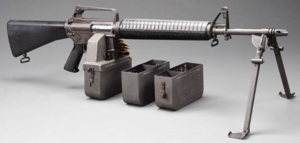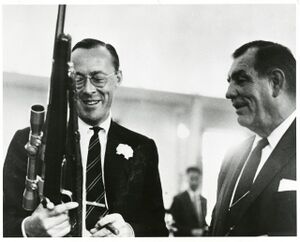Redhawk Firearms
 | |
| Industry | Firearms Defense |
|---|---|
| Founded | March 7, 1957 |
| Headquarters | East Bank, Shenandoah |
Key people | CEO: |
| Products | See list |
Redhawk Firearms is a Shenandoahan small arms engineering and manufacturing company founded in the late 1950's in East Bank, Shenandoah. Many of its products were designed by the famous firearms engineer Earl Rock, who later went on to work for <company name> in Piedmont and continued to design firearms. Firearms designed by Rock and others with Redhawk Firearms were some of the first to utlize foam-filled fiberglass butt/stock furniture, and composite barrels using a steel liner inside an aluminum sleeve, including the iconic Redhawk RRP-5 Rifle and Redhark RRP-9 Rifle, the later of which was until 2023 the mainstay rifle issued by the Shenandoahan National Guard.
History
In the early 1950's, Earl Rock was employed as a design engineer with Blackrock Arms in Tidewater. Rock had submitted several concepts to management at Blackrock showcasing his ideas for a new bolt and carrier piston system to be utilized on semiautomatic rifles without receiving much interest from the more tradition-bound executives at Blackrock. Disillusioned with tje company, Rock terminated his employment and in 1955 and set about looking for financial backers to invest in his own start up firearms company. After several false starts, he turned to a childhood acquaintance, John Wayne Muncie, for support. Muncie, whose family was deeply involved in the coal extraction industry, would provide the financial capital to start the company, while Rock and several others, notably George Stanton and Harold Lauber, would begin designing and producing a series of rifles based on Rock's ideas. Redhawk Firearms was formally established in 1957 in East Bank.
While some of their initial offerings, including the RRP-1 Hillsman, RRP-3 Survival Rifle and RRP-4 Explorer saw limited commercial and military success, the majority of Rock's and the design teams time was spent developing and testing various prototypes that would eventually become the Redhawk RP-5 Rifle chambered for the .260 Grady round. The RRP-5, based on Rock's 4th prototype rifle, featured the revolutionary gas-operated, rotating bolt system that would become the hallmark of his future designs. Leveraging the M<uncie family's financial and political connections, Rock and the Redhawk design team were able to get the attention of Kanawha Armory and provided four prototype rifles for testing and evaluation for the purpose of replacing the venerable yet outdated Crosby M-2 Rifle, which at the time was the standard arm of the National Guard along with the Grady Repeating Arms M-2A1 Carbine. It was well known to the Shenandoahan military that the Copperhead Republican Army had recently adopted a new semiautomatic battle rifle, the Weston Pattern 1957 Rifle, and that an upgrade was desperately needed. Domestically, no suitable design had been forthcoming from Grady Repeating Arms, and the Crosby Firearms Concern, which had produced the M-2 Rifle, was undergoing serious internal turmoil following the sudden death of Gordan J. Crosby, the company's founder and principal design engineer. The ongoing conflict in Omand and sour relations between Shenandoah and Trinovantum prevented serious evaluation of other contemporary designs. The then in development Blitz & Keckler Sturmgewehr 61 was considered, but the weapon was still in development and orders for Ostlander units, especially to recover form losses suffered during the recently concluded Fourth Ostlander-Trinovantan War meant that orders would not be fulfilled under several years after the rifle was accepted into service with the Bodentruppen, or that a domestic firearms company, such as Grady Repeating Arms, would have to acquire technical packages and tooling from Ostlichtor to begin domestic production for both the rifle and its 7.92×41 mm round. As such, the RRP-5 was the only real choice, and testing and evaluation of the weapon began in 1958. Redhawk Firearms did not, however, have the means to produce vast quantities of rifles for the military, and thus were forced to outsource production to Kanawha Armory.
In 1970, the Shenandoahan National Guard issued a request for prototypes for a new rifle chambered in an intermediate cartridge, prefering to move away from the full sized rifle rounds for individual weapons in an effort to increase both the standard magazine capacity of the weapon as well as the ammunition load that could be reasonably carried by a infantrymen. Initially, Rock submitted a design based on a scaled down version of the Redhawk RRP-6, designated RRP-8, but flaws with the design during testing resulted in its rejection by the Army National Guard, who served as the principal testing agency for firearms. Rock and his team then took the existing RRP-5 design and scaled it down for the newly developed .224 Grady cartridge ro meet this requirement. This rifle which would be designated as the Redhawk RRP-9, would go onto to be accepted into service by the National Guard as the Redhawk Firearms M-4 Assault Rifle. Blackrock Arms approched Redhawk in 1975 regarding acquiring rights to produce a series of rifles based on the RRP-9. While Muncie was initially interested in the deal, Rock blanched, not wanting to allow his former employer, who in his opinion had disdained his innovations, to profit from his work. As such, no deal was reached and Blackrock Arms would not receive authorization to product any RRP-9 pattern rifles until 2010 when they released the Blackrock R-5.
Earl Rock continued to attempt improvements to the RRP-6 and RRP-8 rifles, often to the determent of other design work and the consternation of John Muncie, who wanted Redhawk to continue to develop firearms for both military and civilian markets. Muncie viewed the RRP-6 and RRP-8 rifles as failures, and continued to block Rocks attempts to develop them further. Redhawk produced a semiautomatic sporting rifle based on the RRP-5 chambered for the popular .243 Grady round, as well as semiautomatic versions of the RRP-9 chambered in both the standard .266 round as well as other offerings, for the civilian firearms market. The RRP-5 also saw a revival during the 1970s, resulting in the creation of an updated version intended as a designated marksman rifle designated RRP-13 and accepted into service by the Army National Guard as the Redhawk Firearms M-3 Precision Rifle in 1973. A replacement for the Grady Automatic Rifle was attempted by Redhawek in the form of the RARP-1 and RARP-2, however neither version saw widespread adoption by the military.

However, In 1978, after a public falling out with Muncie during a board meeting, Earl Rock resigned from Redhawk Firearms. In 1979, he accepted a job with Piedmont based firearms company <name> and continued his work developing the RRP-8, which would go on to become <whatever Duffey decides to call the Stoner 63>.
George Stanton assumed Earl Rocks role as chief design engineer immediately following Rock's departure from the company and continued to push involation and adaptations of the RRP-9 rifle, his first original contribution being the development of the PCC-80, a pistol-caliber carbine chambered in a variety of standard rounds intended for both military and law enforcement use. Improvements to the RRP-9 design were forthcoming int he mid 1980s, resulting in several improved versions of the M-4 Assault Rifle, including the development of a carbine-length version designed to finally replace the extreme outdated Grady Repeating Arms M-2A1 Carbines still in service. This development would eventually lead to the introduction of the Redhawk Firearms M-3 Carbine in the early 1990s. The final entry to the RRP-9 family under the direction of Stanton was the Redhawk Firearms M-4 Precision Rifle, a marksman's rifle designed around the newly developed .243 GSM round. Though a well preforming round ballistically speaking, its sue with the M-4 Precision Rifle limited the magazine capacity to 15-rounds and was unpopular with operators. In 2016, a newer version of the M-4 Precision Rifle has was developed chambered for the .277 Grady round which would allows the operator to use standard rifle magazines with a 30 round capacity. George Stanton retired from Redhawk in 2005 at the age of 67.
Stanton was succeeded in his role as chief designer engineer by William Kinney, an apprentice of both his and Harold Lauber. Kinney is responsible for most of the design work on Redhawk RRP-18 rifle, which was accepted into service by the National Guard as the Redhawk Firearms M-4 Carbine. This rifle departments from the Rock-designed gas-operated rotating bolt system and is instead a gas-operated short-stroke piston system retaining the a similar rotating bolt arrangement. This same system is also featured on the RRP-21 and RRP-23 rifles, in service with the National Guard as the Redhawk Firearms M-2 Automatic Rifle and Redhawk Firearms M-5 Precision Rifle respectively.

